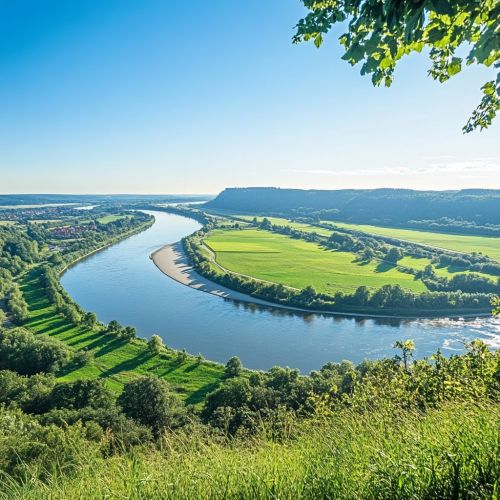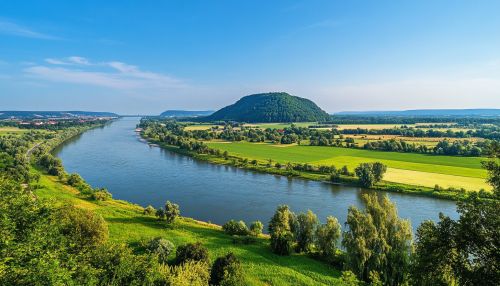Elbe River: Difference between revisions
(Created page with "== Introduction == The Elbe River is one of the major rivers of Central Europe, flowing through the Czech Republic and Germany before emptying into the North Sea. It has a length of approximately 1,094 kilometers (680 miles) and a drainage basin covering an area of about 148,268 square kilometers. The Elbe River has played a significant role in the history, economy, and ecology of the regions it traverses. == Geography == The Elbe River originates in the Krkonoše Mount...") |
No edit summary |
||
| Line 7: | Line 7: | ||
In Germany, the Elbe flows northwestward, passing through major cities such as Dresden, Magdeburg, and Hamburg. The river finally empties into the North Sea near Cuxhaven. The Elbe River basin includes several tributaries, the most significant of which are the Vltava, Saale, Havel, and Mulde rivers. | In Germany, the Elbe flows northwestward, passing through major cities such as Dresden, Magdeburg, and Hamburg. The river finally empties into the North Sea near Cuxhaven. The Elbe River basin includes several tributaries, the most significant of which are the Vltava, Saale, Havel, and Mulde rivers. | ||
[[Image:Detail-98059.jpg|thumb|center|Scenic view of the Elbe River flowing through a lush green landscape with a clear blue sky.|class=only_on_mobile]] | |||
[[Image:Detail-98060.jpg|thumb|center|Scenic view of the Elbe River flowing through a lush green landscape with a clear blue sky.|class=only_on_desktop]] | |||
== Hydrology == | == Hydrology == | ||
Latest revision as of 21:30, 21 September 2024
Introduction
The Elbe River is one of the major rivers of Central Europe, flowing through the Czech Republic and Germany before emptying into the North Sea. It has a length of approximately 1,094 kilometers (680 miles) and a drainage basin covering an area of about 148,268 square kilometers. The Elbe River has played a significant role in the history, economy, and ecology of the regions it traverses.
Geography
The Elbe River originates in the Krkonoše Mountains of the Czech Republic, near the border with Poland. The source of the Elbe is located at an elevation of about 1,386 meters above sea level. From its source, the river flows southwestward through the Czech Republic, passing through the cities of Hradec Králové and Pardubice, before entering Germany.
In Germany, the Elbe flows northwestward, passing through major cities such as Dresden, Magdeburg, and Hamburg. The river finally empties into the North Sea near Cuxhaven. The Elbe River basin includes several tributaries, the most significant of which are the Vltava, Saale, Havel, and Mulde rivers.


Hydrology
The hydrology of the Elbe River is characterized by its seasonal flow variations, influenced by precipitation patterns and snowmelt in the catchment area. The river experiences its highest flow rates during the spring months, primarily due to snowmelt in the Krkonoše Mountains. The average discharge of the Elbe River at its mouth is approximately 870 cubic meters per second.
The Elbe River basin is subject to periodic flooding, which has historically caused significant damage to settlements and infrastructure along its course. Major floods occurred in 2002 and 2013, leading to extensive efforts to improve flood management and mitigation measures.
Ecology
The Elbe River supports a diverse range of ecosystems and habitats, including riparian forests, wetlands, and floodplains. These habitats are home to numerous plant and animal species, some of which are rare or endangered. The river's biodiversity is influenced by factors such as water quality, flow regime, and land use in the surrounding areas.
Efforts to improve water quality in the Elbe River have been ongoing since the late 20th century. Industrial pollution, agricultural runoff, and urban wastewater have historically contributed to the degradation of water quality. However, initiatives such as the International Commission for the Protection of the Elbe River (ICPER) have led to significant improvements in recent decades.
Historical Significance
The Elbe River has played a crucial role in the history of Central Europe. It served as a natural boundary for various historical territories and was a vital trade route during the medieval period. The river facilitated the movement of goods and people, contributing to the economic development of the regions along its course.
During World War II, the Elbe River was a significant strategic location. The river marked the meeting point of the Western Allies and Soviet forces in April 1945, symbolizing the impending defeat of Nazi Germany. The "Elbe Day" is commemorated annually to mark this historic event.
Economic Importance
The Elbe River remains an important economic artery for the regions it traverses. It supports various economic activities, including shipping, agriculture, and tourism. The river is navigable for a significant portion of its length, allowing for the transportation of goods between inland ports and the North Sea.
The Port of Hamburg, located on the Elbe River, is one of the largest and busiest ports in Europe. It serves as a major hub for international trade, handling a wide range of cargo, including containers, bulk goods, and vehicles. The port's strategic location and advanced infrastructure contribute to its significance in global trade networks.
Environmental Challenges
Despite improvements in water quality, the Elbe River faces several environmental challenges. Pollution from industrial and agricultural sources continues to impact the river's ecosystems. Additionally, climate change poses a threat to the river's hydrology, with potential impacts on flow patterns, water temperature, and flood frequency.
Efforts to address these challenges include the implementation of stricter environmental regulations, the promotion of sustainable agricultural practices, and the restoration of natural habitats. Collaborative initiatives involving governments, non-governmental organizations, and local communities are essential for the long-term protection and management of the Elbe River.
See Also
- Vltava River
- Saale River
- Havel River
- Port of Hamburg
- Krkonoše Mountains
- International Commission for the Protection of the Elbe River
